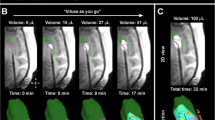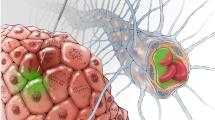Abstract
With emerging drug delivery technologies becoming accessible, more options are expected to become available to patients with glioblastoma (GBM) in the near future. It is important for clinicians to be familiar with the underlying mechanisms and limitations of intratumoral drug delivery, and direction of recent research efforts. Tumor-adjacent brain is an extremely complex living matrix that creates challenges with normal tissue intertwining with tumor cells. For convection-enhanced delivery (CED), the role of tissue anisotropy for better predicting the biodistribution of the infusate has recently been studied. Computational predictive methods are now available to better plan CED therapy. Catheter design and placement—in addition to the agent being used—are critical components of any protocol. This paper overviews intratumoral therapies for GBM, highlighting key anatomic and physiologic perspectives, selected agents (especially immunotoxins), and some new developments such as the description of the glymphatic system.

Similar content being viewed by others
References
Stupp R et al (2005) Radiotherapy plus concomitant and adjuvant temozolomide for glioblastoma. N Engl J Med 352(10):987–996
Stupp R et al (2012) NovoTTF-100A versus physician’s choice chemotherapy in recurrent glioblastoma: a randomised phase III trial of a novel treatment modality. Eur J Cancer 48(14):2192–2202
Juratli TA, Schackert G, Krex D (2013) Current status of local therapy in malignant gliomas: a clinical review of three selected approaches. Pharmacol Ther 139(3):341–358
Kanu OO et al (2009) Glioblastoma multiforme: a review of therapeutic targets. Expert Opin Ther Targets 13(6):701–718
Engelhard HH, Groothuis DG (1999) The blood–brain barrier: structure, function, and response to neoplasia. In: Berger MS, Wilson CB (eds) The gliomas. W.B. Saunders Company, Philadelphia, pp 115–121
Iliff JJ et al (2012) A paravascular pathway facilitates CSF flow through the brain parenchyma and the clearance of interstitial solutes, including amyloid beta. Sci Transl Med 4(147):47ra111
Bansal K, Engelhard HH (2000) Gene therapy for brain tumors. Curr Oncol Rep 2(5):463–472
Engelhard HH (2000) The role of interstitial BCNU chemotherapy in the treatment of malignant glioma. Surg Neurol 53(5):458–464
Fung LK et al (1996) Chemotherapeutic drugs released from polymers: distribution of 1,3-bis(2-chloroethyl)-1-nitrosourea in the rat brain. Pharm Res 13(5):671–682
Strasser JF et al (1995) Distribution of 1,3-bis(2-chloroethyl)-1-nitrosourea and tracers in the rabbit brain after interstitial delivery by biodegradable polymer implants. J Pharmacol Exp Ther 275(3):1647–1655
Meggs WJ, Hoffman RS (1998) Fatality resulting from intraventricular vincristine administration. J Toxicol Clin Toxicol 36(3):243–246
Jordan MA et al (1993) Mechanism of mitotic block and inhibition of cell proliferation by taxol at low concentrations. Proc Natl Acad Sci U S A 90(20):9552–9556
Lidar Z et al (2004) Convection-enhanced delivery of paclitaxel for the treatment of recurrent malignant glioma: a phase I/II clinical study. J Neurosurg 100(3):472–479
Sampson JH, B.M., Raghavan R, Mehta AI, Friedman AH, Reardon DA, Petry NA, Barboriak DP, Wong TZ, Zalutsky MR, Lally-Goss D, Bigner DD (2010) Co-localization of gadolinium-DTPA with high molecular weight molecules after intracerebral convection-enhanced delivery in man. Neurosurgery, In Press
Krauze MT et al (2005) Effects of the perivascular space on convection-enhanced delivery of liposomes in primate putamen. Exp Neurol 196(1):104–111
Sonabend AM et al (2011) Prolonged intracerebral convection-enhanced delivery of topotecan with a subcutaneously implantable infusion pump. Neuro Oncol 13(8):886–893
Sillay K et al (2013) Convection enhanced delivery to the Brain: preparing for gene therapy and protein delivery to the Brain for functional and restorative Neurosurgery by understanding low-flow neurocatheter infusions using the Alaris((R)) system infusion pump. Ann Neurosci 20(2):52–58
Laske DW, Youle RJ, Oldfield EH (1997) Tumor regression with regional distribution of the targeted toxin TF-CRM107 in patients with malignant brain tumors. Nat Med 3(12):1362–1368
Weaver M, Laske DW (2003) Transferrin receptor ligand-targeted toxin conjugate (Tf-CRM107) for therapy of malignant gliomas. J Neurooncol 65(1):3–13
Kunwar S et al (2007) Direct intracerebral delivery of cintredekin besudotox (IL13-PE38QQR) in recurrent malignant glioma: a report by the Cintredekin Besudotox Intraparenchymal Study Group. J Clin Oncol 25(7):837–844
Bobo RH et al (1994) Convection-enhanced delivery of macromolecules in the brain. Proc Natl Acad Sci USA 91(6):2076–2080
Raghavan R et al (2006) Convection-enhanced delivery of therapeutics for brain disease, and its optimization. Neurosurg Focus 20(4):E12
Ding D et al (2010) Convection-enhanced delivery of free gadolinium with the recombinant immunotoxin MR1-1. J Neurooncol 98(1):1–7
Sampson JH et al (2010) Poor drug distribution as a possible explanation for the results of the PRECISE trial. J Neurosurg 113(2):301–309
Sampson J. H. et al. (2007) Intracerebral infusate distribution by convection-enhanced delivery in humans with malignant gliomas: descriptive effects of target anatomy and catheter positioning. Neurosurgery, 60(2 Suppl 1): p ONS89-98; discussion ONS98-9
Tanner P. G. et al. (2007) Effects of drug efflux on convection-enhanced paclitaxel delivery to malignant gliomas: technical note. Neurosurgery, 61(4): p E880-2; discussion E882
Raghavan R et al (2010) Fluid infusions from catheters into elastic tissue: I. Azimuthally symmetric backflow in homogeneous media. Phys Med Biol 55(1):281–304
Ivanchenko O. et al. (2010) Design of backflow-free catheters based on micro-fluid dynamics, in BMES 2010 annual fall meeting, Austin
Raghavan R. (2010) Intraparenchymal delivery and its discontents. Drug delivery to the central nervous system, p 85–135
Li D et al. (2010) Optimal catheter placement for chemotherapy, in proceedings of 20th european symposium on computer aided process engineering (ESCAPE), p 223–228
Somayaj MB et al (2008) Systematic design of drug delivery therapies. Comp Chem Eng 32:89–98
Zhang L et al (2007) Discovery of transport and reaction properties in distributed systems. AIChE J 53(2):381–396
Sampson JH et al (2007) Clinical utility of a patient-specific algorithm for simulating intracerebral drug infusions. Neuro-oncology 9(3):343–353
Raghavan R, and M. Brady (2011) Predictive models of pressure-driven infusions into brain parenchyma. Phys Med Biol, In Press
Linninger AA et al (2008) Computational methods for predicting drug transport in anisotropic and heterogeneous brain tissue. J Biomech 41(10):2176–2187
Linninger AA et al (2008) Prediction of convection-enhanced drug delivery to the human brain. J Theor Biol 250(1):125–138
Linninger AA et al (2008) Rigorous mathematical modeling techniques for optimal delivery of macromolecules to the brain. IEEE Trans Biomed Eng 55(9):2303–2313
Ivanchenko O, Sindhwani N, Linninger A (2012) Exact solution of the convection-diffusion problem in cylindrical geometry. AIChE J 58(4):1299–1302
Sindhwani N et al (2011) Methods for determining agent concentration profiles in agarose gel during convection-enhanced delivery. IEEE Trans Biomed Eng 58(3):626–632
Ivanchenko O, Sindhwani N, Linninger A (2010) Experimental techniques for studying poroelasticity in brain phantom gels under high flow microinfusion. J Biomech Eng 132(5):051008
Maier-Hauff K et al (2011) Efficacy and safety of intratumoral thermotherapy using magnetic iron-oxide nanoparticles combined with external beam radiotherapy on patients with recurrent glioblastoma multiforme. J Neurooncol 103(2):317–324
Lueshen E et al (2014) Intrathecal magnetic drug targeting using gold-coated magnetite nanoparticles in a human spine model. Nanomedicine (Lond) 9(8):1155–1169
Lueshen E et al (2014) Implant-Assisted intrathecal magnetic drug targeting to aid in the therapeutic nanoparticle localization for potential treatment of central nervous system disorders. J Biomed Nanotechnol 11(2):253–261
Wang P, Olbricht WL (2011) Fluid and solid mechanics in a poroelastic network induced by ultrasound. J Biomech 44(1):28–33
Kunwar S et al (2006) Safety of intraparenchymal convection-enhanced delivery of cintredekin besudotox in early-phase studies. Neurosurg Focus 20(4):E15
Vogelbaum MA et al (2007) Convection-enhanced delivery of cintredekin besudotox (interleukin-13-PE38QQR) followed by radiation therapy with and without temozolomide in newly diagnosed malignant gliomas: phase 1 study of final safety results. Neurosurgery 61(5):1031–1037; discussion 1037–1038
Rand RW et al (2000) Intratumoral administration of recombinant circularly permuted interleukin-4-Pseudomonas exotoxin in patients with high-grade glioma. Clin Cancer Res 6(6):2157–2165
Weber F et al (2003) Safety, tolerability, and tumor response of IL4-Pseudomonas exotoxin (NBI-3001) in patients with recurrent malignant glioma. J Neurooncol 64(1–2):125–137
Schlingensiepen R et al (2005) Intracerebral and intrathecal infusion of the TGF-beta 2-specific antisense phosphorothioate oligonucleotide AP 12009 in rabbits and primates: toxicology and safety. Oligonucleotides 15(2):94–104
Patel SJ et al (2005) Safety and feasibility of convection-enhanced delivery of Cotara for the treatment of malignant glioma: initial experience in 51 patients. Neurosurgery 56(6):1243–1252; discussion 1252–1253
Author information
Authors and Affiliations
Corresponding author
Rights and permissions
About this article
Cite this article
Mehta, A.I., Linninger, A., Lesniak, M.S. et al. Current status of intratumoral therapy for glioblastoma. J Neurooncol 125, 1–7 (2015). https://doi.org/10.1007/s11060-015-1875-1
Received:
Accepted:
Published:
Issue Date:
DOI: https://doi.org/10.1007/s11060-015-1875-1




